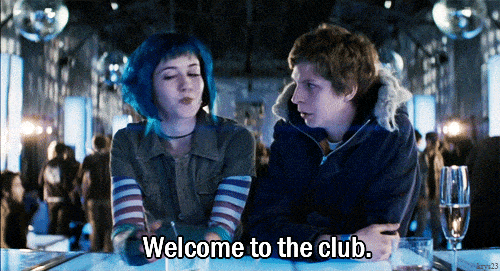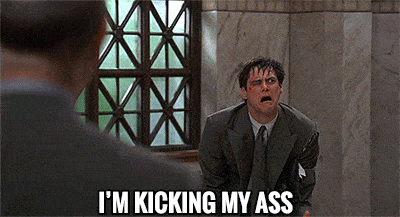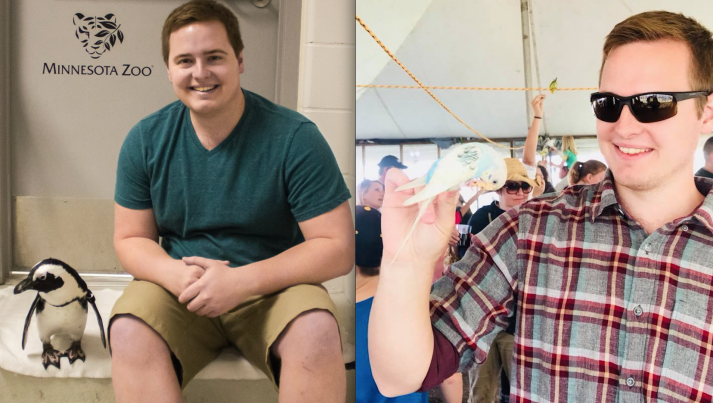Originally posted at: http://www.nerdfitness.com/
So you fell off the wagon already.
Welcome to the club.
It’s called “being human!”
There are like 7 billion of us.

So how did I know you probably fell off the fitness wagon already?
Because statistically speaking, MOST people have already abandoned or missed out on a lot of the resolutions they’ve set for 2019. Seriously.
As somebody who has fallen off the wagon many a time in the past, but managed to stay ON the wagon this time…
Here’s my step-by-step guide for you to get back on track.
STEP 1: FORGIVE YOURSELF.
I heard a podcast interview recently about a man who had made a huge realization through seeing a therapist.
Specifically, their therapist asked them “Would you talk to somebody the way you talk to yourself?”
I bet the answer is a RESOUNDING “No.”
Nobody deserves that kind of abuse.
We’re often our own worst critic, and our own worst enemy:

You know that voice in your head, that one calling you a loser or a failure? Treat it like a different person. You’re under no obligation to listen to it! It’s not you.
“Oh you think I’m a piece of s** and that’s why I can’t stick with a workout routine? I disagree strongly. I might have some faults, but I’m here, and I’m still trying. So shut up and get out of my way.”
You’re reading this, which means you’re trying. Forgive yourself. And move on.
STEP 2: RECOGNIZE YOUR SCIENCE EXPERIMENT FAILED. MOVE ON.
Your goal of hitting the gym 2 hours a day and only eating Keto failed after three weeks.
Congratulations!
You conducted an experiment that did not have the results you expected.
That’s neither a good nor a bad thing. Like any other experiment, it just… IS.
So write down specifically what your experiment entailed. What did you try to do?
- I was going to exercise every day.
- I was going to run a mile each morning.
- I was going to eat strictly Paleo every day.
Look at your list: this is a combination of variables that doesn’t work for your lifestyle.
SIDENOTE: Learning from the millions of people that have come through Nerd Fitness over the past decade, my guess is that your experiment didn’t work out for one of two reasons:
- Your goals were too vague: “I should exercise more this year” – For how long? How often? What kind of exercise?
- You tried to change ALL the things: eat 1,800 calories a day (instead of your normal 3,000), go to CrossFit 5 days a week (when you don’t exercise at all now), and get 8 hours of sleep a night (normally you get 5).
STEP 3: CHANGE A VARIABLE IN YOUR EXPERIMENT.
You’re reading this email, which would lead me to believe you’re interested in trying again to lose weight and get in shape.
To avoid getting the same results, we need to change the variables in the experiment to try and get different results. You know, science.

For your next attempt consider adjusting one of the following variables. And remember, any good experiment has accurate measurements for their changing factors! You don’t just put “some uranium” in a nuclear reactor. You know the exact amount.
So be exact with your variables.
Let me give you some suggestions:
- Change the exercise variable: Did you actually enjoy the exercise you attempted? If you discovered that you hate running or bootcamps, great! Never ever do those things again. “Exercise sucks,” so I would pick something you actually enjoy.
- Try a substitution rather than addition: ADDING a brand new exercise routine into a busy schedule can be really challenging. Fortunately, you can focus on substituting or adding in a way that doesn’t take up more time: nutrition! How you eat is 80-90% of the weight loss equation, and you’re already eating every day. So focus on substituting a vegetable for fries once a week, or swapping sparkling water for soda. Keeping a food journal and change up your breakfast twice a week.
- Adjust your “win scenario”: I get it. You were able to hit the gym 4 days a week for the first few weeks of this year, going for at least an hour. But THEN…your kid got sick. And you only had 30 minutes, which wasn’t enough time to get a workout in. And then YOU got sick. So why not set the win scenario at “30 minutes,” or “15 minutes,” or just “1 exercise”? Lower the bar!
This is a 10-year journey we’re on here, so the exercise itself is not nearly as important as building a routine of working out that fits into your life. So lower the bar for what a “win” scenario is for you.
Example: if you walk into the gym and do 1 set of 1 exercise, it counts as a win. Doesn’t matter if you’re there for an hour or for 5 minutes to do a set of push-ups and then leave. It all counts.
STEP 4: RESPAWN, GET BACK IN THE FIGHT.
When you play a challenging video game, you’re going to die. A lot. (I died literally thousands of times while playing my two favorite games of the past year – Hollow Knight and Celeste).
What happens after you die in a game?
You respawn, and try again!
You’ve learned a new tactic or pattern. You have a new technique. You’ve uncovered a secret. Or you’ve just gotten better. So you try, again.
And again.
And again.
And when you finally succeed?
Nirvana. Adulation. Pure joy.
There’s no shame in failing when it comes to weight loss. We have hundreds of stories of people who kept failing, but kept reading and trying, and then finally – something clicked.
And that next attempt is the one that changed their life’s path. Like Joe, who made like a dozen weight loss attempt until he changed the right variable and got results:

So try again today. And keep these things in mind:
- Change your nutrition variable: try calorie counting instead of Paleo or vice versa.
- Change your workout variable: try strength training instead of running.
- Focus on building the routine by making the ‘win scenario’ super small.
Write down your plan, and start executing.
STEP 5: SUPERCHARGE YOUR RESULTS
I know hacking your experiments to get better data isn’t exactly “scientifically smart” or “morally responsible,” but I’m the one writing this email and I have more important stuff to say so you’re just gonna have to deal with it.
Once you start your new experiment, here’s how you can stack the deck in your favor:
Write everything down. Write down your workouts. Write down what you eat. Treat it like a science experiment, and you’re collecting data! Plan ahead. Be PRO-active (“I will do Strength Training Workout A at 4pm and tonight I’ll have roasted chicken and bacon wrapped asparagus) instead of RE-active (“What should I do for exercise right now?” and “Ah, what’s for dinner? Oooh, Burger King!”)
Recruit allies to your team. Don’t go this alone, as you’re more likely to succeed based on the people you spend time with and hang around. So recruit allies. Start spending more time with healthy people that empower you, rather than unhealthy people that enable you and drag you down. Join a running club. Find a lifting buddy. Somebody you can check in with.
Hire a professional. There are two types of coaches worth the investment:
- An in-person trainer if you are looking to supercharge your form on specific exercises like Olympic lifts, squats, deadlifts, etc. An in-person trainer can be good for people that need the accountability of somebody they’ve paid to meet them in the gym.
- An online coach that represents mobile, worldwide accountability. I’ve had a coach for 4 years and it’s changed my life. Knowing that I have a workout and nutrition strategy to follow each day is game-changing.
GET BACK IN THE FIGHT
An old baboon named Rafiki once taught me: “Yes, the past can hurt. But you can either run from it, or learn from it.”
Okay maybe he taught that to Simba in The Lion King, but I too learned the same lesson:

TO RECAP:
Forgive yourself. You wouldn’t talk to somebody else the way you talk to yourself, so have some freaking compassion. You’re trying.
Identify what experiment you JUST tried. Write down what you believe went wrong over the past few weeks. Congrats – you found a strategy that doesn’t work.
Pick a new path, try a different variable. A good scientist meticulously tracks their data and writes down their hypothesis. I would change one of the following:
- Exercise: do less – focus on building the routine and doing it consistently.
- Nutrition: change less. If you couldn’t stick with a diet for 3 weeks, it was too restrictive. Try a different path.
- Win scenario: don’t let “perfect” be the enemy of “good.”
And then try again.
Recruit allies, hire a coach, plan ahead. But start.
-Steve
PS: If you’re overwhelmed and came to the realization you can’t do this on your own, you’re not alone!
I hired an online coach because I wanted better results and it’s been the best investment I’ve made. If you want step-by-step instruction and accountability, our coaches are ready to help you with every step of this process!
###
Photo Citation: Oh My Goodness! Shut Me Down
Filed under: Fitness

 For now classes are 6pm and 640pm at 2840 Wildwood st in the Boise Cloggers studio.
Book your class NOW!
click this ==>
For now classes are 6pm and 640pm at 2840 Wildwood st in the Boise Cloggers studio.
Book your class NOW!
click this ==>








